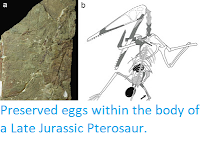The Pterosaurs were an extinct group of flying Archosaurs that existed
from the late Triassic to the end of the Cretaceous Period (210 to 65.5
million years ago). They are thought to have been warm blooded, as many
specimens have been found that appear to have had fury skins. Their
wings were flaps of skin membrane, similar to that of Bats, supported by
elongated fourth fingers and attached to the flanks of the body and
legs. Unlike Birds they appear to have been capable of flying before
reaching their full adult size, and appear to have taken several years
to reach maturity. The largest Pterosaurs achieved wingspans in excess
of 7 m, roughly twice that of the largest extant Birds. Despite their long history and high diversity, the fossil record of
Pterosaurs is somewhat limited, probably due to their lightweight,
fragile skeletons, with most known Pterosaur fossils coming from a
relatively small number of localities. Istiodactylid Pterosaurs are characterised by rhombic teeth with lancet-shaped crowns, long skulls with short pre-antorbital portions of the rostrum (long snout in front of the opening before the eye), and nasoantorbital fenestrae (opening on the snout in front of the eye) representing over 50% of the total skull length and height. All istiodactylid pterosaurs are from the Early Cretaceous Jiufotang Formation of northeastern China with the exception of Istiodactylus latidens, which is from the Early Cretaceous Vectis Formation of the Isle of Wight, Southern England.
In a paper published in the journal PeerJ on 19 September 2019, Xuanyu Zhou of the Institute of Geology of the Chinese Academy of Geological Sciences, and the China University of Geosciences, Rodrigo Pêgas of the Laboratory of Vertebrate Paleontology and Animal Behavior at the Universidade Federal do ABC, Maria Leal of the Departamento de Geologia at the Universidade Federal do Ceará, and the Zoological Museum at Copenhagen University, and Niels Bonde, also of the Zoological Museum at Copenhagen University, and of the Fur Museum, describe a new species of Istiodactylid Pterosaur from the Early Cretaceous Jiufotang Formation of Liaoning Province, China.
The Jiufotang Formation is known worldwide for its paleontological richness and the exquisite preservation of its fossils, which include Plants, Insects, Fish, Mammal, Birds, non-Avian Dinosaurs, and Pterosaurs. The formation is 206–2685 m thick and is mainly composed of mudstone, siltstone, shale, sandstone and tuff. A tuff (volcanic ash horizon) from the basal part of formation (two metres above the boundary between the Yixian and Jiufotang formations) in western Liaoning has been dated to 122.1 million years ago, while a basalt layer in the upper part of the formation in Inner Mongolia has been dated to 110.59 million years ago, though it is unclear how well this correlates to the upper part of the formation in Liaoning. The Jiufotang Formation and the underlying Yixian Formation traditionally constitute the Jehol Group, which has yielded the famous Jehol Biota. Four fossil-bearing levels with partly different fossil associations have been distinct within the Yixian Formation and only one in the Jiufotang Formation.
The new Pterosaur species is placed in the genus Nurhachius, which currently contains only one species, Nurhachius ignaciobritoi, also from the Jiufotang Formation, and is given the specific name luei, in honour of the late Junchang Lü, of the Institute of Geology of the Chinese Academy of Geological Sciences, for his contributions to the study of Chinese Pterosaurs. Nurhachius luei is described from a single specimen comprising a skull with mandible and seven articulated cervical vertebrae.
Nurhachius luei, photograph, and line drawing. The scale bar in the line drawing equals 50 mm. Abbreviations: alv, alveolus; an, angular; art, articular; ax, axis; ceI, ceratobranchial I; ch, choana; cv, cervical vertebra; d, dentary; f, frontal; j, jugal; la, lacrimal; m, maxilla; n, nasal; naof, nasoantorbital fenestra; odp, odontoid process; or, orbit; pa, parietal; pf, prefrontal; pmax, premaxilla; po, postorbital; prid, palatal ridge; pty, pterygoid; q, quadrate; vo, vomer. Isolated numbers indicate tooth positions. Note: the visible region of the pterygoid corresponds to the medial process of the bone. Photo by Xuanyu Zhou, drawing by Maria Eduarda Leal. Zhou et al. (2019).
The skull of Nurhachius luei is exposed in right lateral view, with some palatal elements that are visible in dorsal view. The mandible is exposed in right dorsolateral view. The skull is 300 mm long from the squamosal to the premaxillary tip (total skull length), and 74 mm high at its greatest height, which is at the level of the occiput. The nasoantorbital fenestra is long, corresponding to 45% of the total skull length (premaxilla to squamosal) and 55% of the length from the craniomandibular joint to the premaxilla. Anterior to the nasoantorbital fenestra, the long axis of the rostrum is slightly deflected dorsally, as in other Istiodactylids. There is a strong palatal keel extending from pre-narial part of the rostrum to the anterior third of the nasoantorbital fenestra. The craniomandibular joint levels with the anterior margin of the orbit.
The premaxilla is fused with the maxilla and the suture is obliterated, thus the boundary between the two bones cannot be traced. Consequently, the premaxillary and maxillary teeth count is unknown. There is no premaxillary crest, as in all other Istiodactylids. The rostral tip of the premaxilla exhibits a slight dorsal deflection of palatal anterior tip, as evidenced from the uplifted positions of the two anteriormost teeth.
See also...
Follow
Sciency Thoughts on Facebook.







